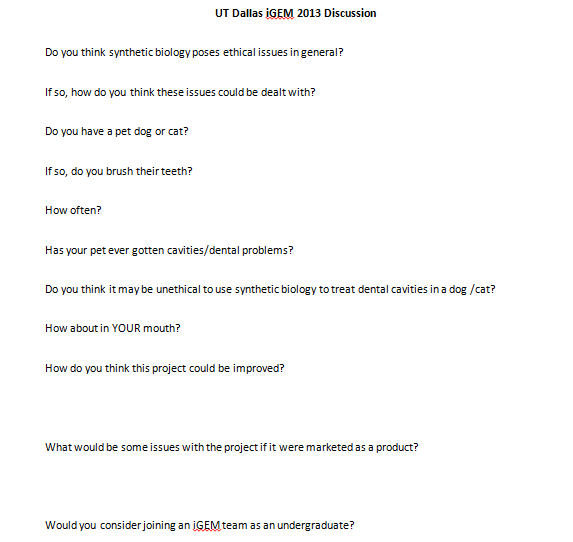Team:UT Dallas/HumanPractices
From 2013.igem.org
(Difference between revisions)
LanaKhazma (Talk | contribs) |
|||
| Line 23: | Line 23: | ||
We have created a Vine for University of British Columbia. Their goal was to compile all iGEM projects in order to create a quick way to view the 200 teams that are competing in iGEM this year. This six second video shows the Streptococcus mutans bacteria attached to the surface of a tooth. The Escherichia coli is moving in with our synthetically engineered biobricks which causes the S. mutans biofilm to break apart. | We have created a Vine for University of British Columbia. Their goal was to compile all iGEM projects in order to create a quick way to view the 200 teams that are competing in iGEM this year. This six second video shows the Streptococcus mutans bacteria attached to the surface of a tooth. The Escherichia coli is moving in with our synthetically engineered biobricks which causes the S. mutans biofilm to break apart. | ||
</div> | </div> | ||
| + | <script language='javascript'> | ||
| + | $('#t5_link').css('color','#982f00'); | ||
| + | </script> | ||
</html> | </html> | ||
Revision as of 01:59, 28 September 2013
Animal Practices
Animal practices are quite varied. Applying and testing the effectiveness of the engineered bacteria on a variety of animals using a slew of different delivery methods (mostly food) would be the first step. Current possible animals include dogs, horses and cows.
Outreach:
We chose to look into the ethical considerations that are at the forefront of synthetic biology. With this in mind, we will be visiting a local high school to present our results and discuss the ethical issues involved in the field of synthetic biology. We will conduct a discussion (please click the picture below) and present the results during the Jamboree.

Collaboration:
We have created a Vine for University of British Columbia. Their goal was to compile all iGEM projects in order to create a quick way to view the 200 teams that are competing in iGEM this year. This six second video shows the Streptococcus mutans bacteria attached to the surface of a tooth. The Escherichia coli is moving in with our synthetically engineered biobricks which causes the S. mutans biofilm to break apart.
Animal practices are quite varied. Applying and testing the effectiveness of the engineered bacteria on a variety of animals using a slew of different delivery methods (mostly food) would be the first step. Current possible animals include dogs, horses and cows.
Outreach:
We chose to look into the ethical considerations that are at the forefront of synthetic biology. With this in mind, we will be visiting a local high school to present our results and discuss the ethical issues involved in the field of synthetic biology. We will conduct a discussion (please click the picture below) and present the results during the Jamboree.

Collaboration:
We have created a Vine for University of British Columbia. Their goal was to compile all iGEM projects in order to create a quick way to view the 200 teams that are competing in iGEM this year. This six second video shows the Streptococcus mutans bacteria attached to the surface of a tooth. The Escherichia coli is moving in with our synthetically engineered biobricks which causes the S. mutans biofilm to break apart.
 "
"